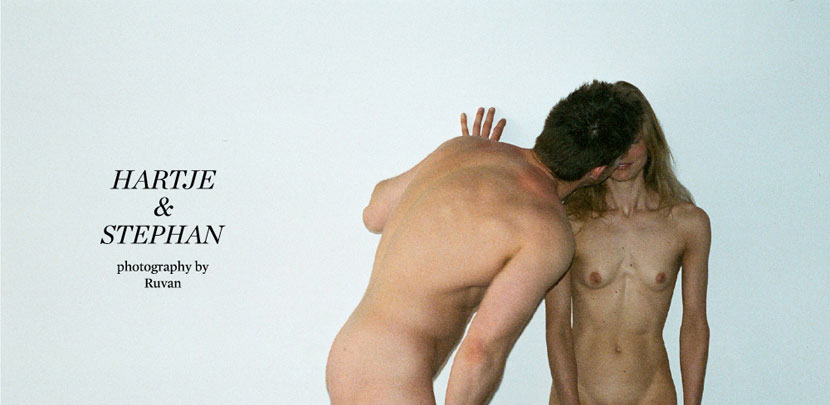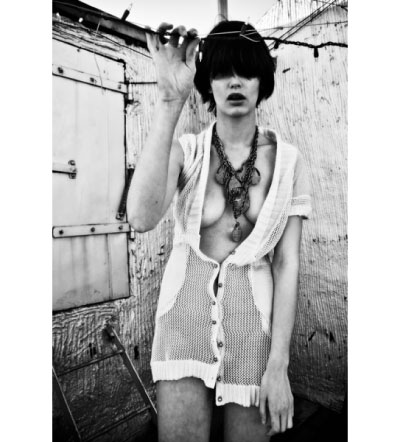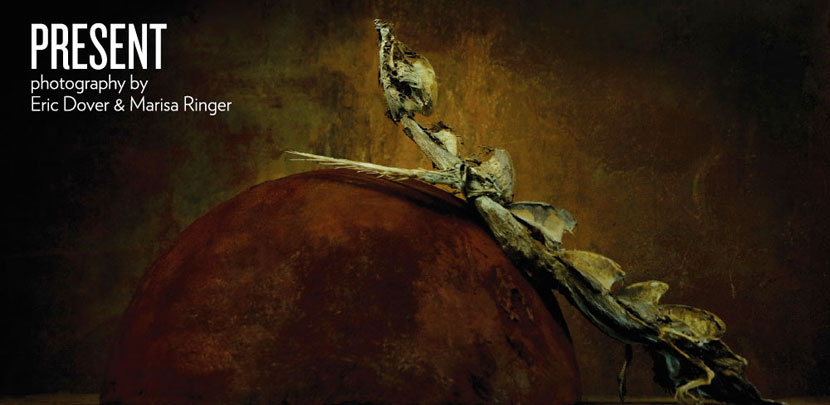Photography by Estelle Hanania Click Image for Slideshow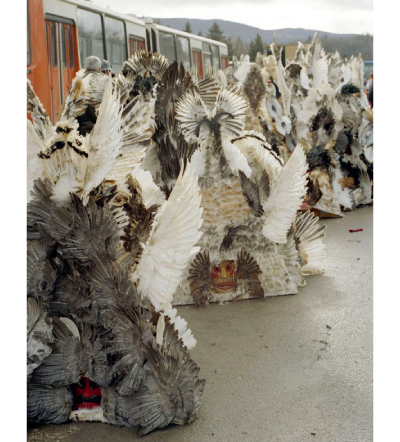
![]()
Estelle Hanania’s images explore otherworldly spaces, the sharp realness of her photographs a startling contrast to the ethereality of their subjects — burning hands, glittery crystals, spookily-real human scarecrows, and men dressed as eery, totem-like birds. Exploring the allure of ritual, costumes, and folk traditions, Hanania’s photography is a beautiful reminder of a certain eccentricity inherent to all cultural beliefs and behaviors.
Hanania tells us, “I don’t take pictures on a daily basis, and everyday life is more visually boring to me than inspiring, most of the time. Visually, I like when strange things collide and provoke questions.” Of her photographs of costumed men at carnivals (which she’s been taking since 2006) she ways, “I’m attracted by a feeling of disorientation and excitement that you can find in these gatherings and costumed traditions…. I loved this kind of situation where everything gets confused and uncertain, but you still can define the most familiar shape which is the human figure, vanishing.”
(more…)


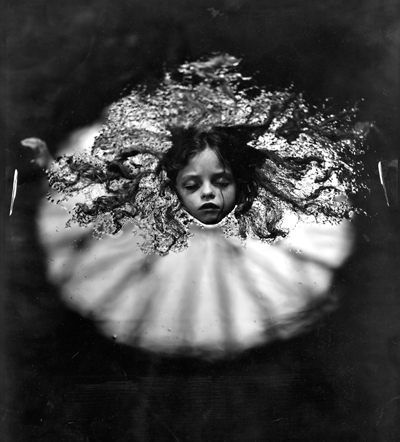
At Warm Springs, 1991, from the series Immediate Family. All photography courtesy of Sally Mann and Gagosian Gallery. (Click images to enlarge)
![]()
Sally Mann’s photography is simultaneously nostalgic and startlingly real, a beautiful depiction of the contemporary South and the more immediate space of the family. Mann’s preoccupations with growth, time, death, and decay are captured in her images of her young children, the old Civil War battlefields that surround her, and the way in which the people and the wild landscape grow, die, and merge together. Her first solo exhibition in the UK, The Family and the Land: Sally Mann looks at her long career in light of her impulse to focus on the physical world surrounding her as her primary subject.
The show draws from perhaps her most well-known series, Immediate Family, as well as Faces, Deep South and What Remains. The exhibition first focuses on her portrayal of her young children in all their innocence and immediacy. Faces and What Remains follow with Mann’s unflinching look into the physicality of being, ultimately demonstrating the bare fact of decomposition after death — the literal merging of bodies back into the earth. Finally, the images in Deep South explore the landscape of the South, focusing on the physical and metaphorical Civil War scars that still mark the land. Displayed in a European context, Mann’s photographs take on a more sharply American sheen, their location abroad more directly connecting to them to life within the intricate, complicated space of the rural American South.
The Family and the Land: Sally Mann is on display at The Photographer’s Gallery in London through September 19.
(more…)


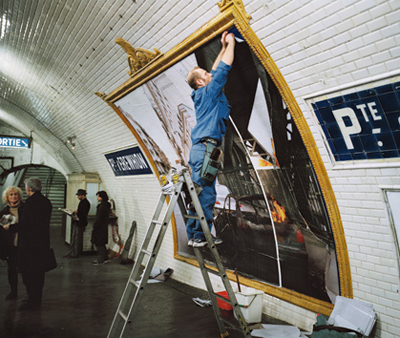
Film stills courtesy of Eric Baudelaire
In the first half of the 20th century, French philosopher Henri Bergson described duration as an invisible process, like sugar dissolving in a glass of water. Using this reference as a jumping-off point, the Paris-based artist Eric Baudelaire has created the film Sugar Water, which is presented at the Hammer Museum in Los Angeles for the artist’s first U.S. solo museum show.
The film takes place on the fictional Paris metro platform at the fictional Porte d’Erewhon, where a billposter descends into the station to cover a large advertising billboard painted bright blue. He continues to wheat-paste a sequence of images that depict a common car parked on an anonymous Parisian street. He continues by then covering that image with one of the same car busting into flames. The billposter continues until the car becomes swallowed up in smoke, and then remains only as a burnt-out skeleton of the former car. All the while, metro riders enter and exit the scene seemingly oblivious to the slow-motion narrative action taking place. Baudelaire hired a real billposter to lay down the imagery, but the commuters who move in and out of the station are all hired actors, enacting a sort of role reversal in which the person upon whom the single camera focuses is not an actor; the “extras” who fill the background, meanwhile, are. Eventually, this cinematic event unfolds over the seventy-two-minute film, creating a slow reflection on images we typically experience in our news media.
(more…)




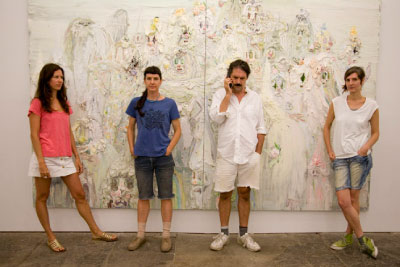
Photography by Derek Peck.

In the oversaturated sea that is the New York City art scene, Canada on the Lower East Side somehow manages to stand out — way out. Due credit should be given to the gallery’s innate fearlessness and to-hell-with-it attitude but bottom line, Canada has a knack for culling some of the best talent around. To critics’ delight, this summer’s Homunculi brought the alchemical mythologies and freakishly skilled talents of Allison Schulnik, Ruby Neri, Matt Greene, and Matthew Ronay out to play. And just last week the gallery hosted Slummer Nights, a 4-night collaborative spectacular organized by Sadie Laska that took the most magical elements of a variety show, underground music festival, and art opening and threw it all together for one rousing good time. Canada’s resident artists offer more of the same. From Joe Bradley’s rudimentary Superman logos to Devendra Banhart’s imaginative, oscillating creatures and Sarah Braman’s found furniture installations, there’s an underlying sense of innocence, determination, and makeshift playfulness embedded in every artist Canada represents. Not to say that the gallery is all fun and games. There’s plenty of provocative, slightly off-kilter work to go around. Just ask Phil Grauer, one of the four owners/partners behind it all.
(more…)

We recently came across Samantha West’s photography and felt the need to share it. Born and raised in New York City, West is inspired by “the curious combination of vintage nudes, birds, Fred Astaire movies, bus rides, mermaids (and their long mermaid hair), horses, barefoot cooking, and planning trips she can’t afford quite yet.”
Published across Europe, Asia and North America, she’s been featured in publications ranging from Vanity Fair Germany to The New York Times. Currently shooting lookbooks for several different fashion designers, West is also making time for her personal project, Musings. She writes, “I love to photograph my friends in their most personal spaces — their bedroom and bath, where intimacy and femininity reign. My focus has always been on the face, skin, pores, lips, hands. I love a unique visage. I love intimacy and honesty.” Finally, she tells us, “I love being able to see a person shine through.”
Her gorgeous, artful images are testament to her firm belief that in photography, “it is all in the eyes.”
(more…)

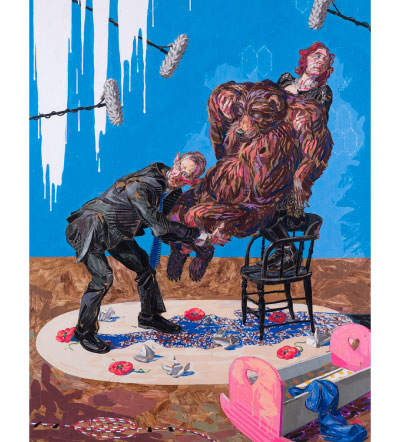
Bears, 2010. Brian Douglas (Elbow-Toe). All images courtesy of the artists and Perry Rubenstein Gallery, New York. (Click image to enlarge)
The collection of works in SHRED, the comprehensive show currently on display at Perry Rubenstein Gallery, explores an artform often maligned: collage. Carlo McCormick, the show’s curator, is not only the senior editor of PAPER magazine but also a longtime defender of New York’s downtown art scene. In this show, from simple, layered newsprint cut-outs to videos comprised of animated paper silhouettes, works by such artists as Bruce Conner, Gee Vaucher, Jack Walls, and the late scene darling Dash Snow demonstrate the powerful potential of collage as a medium even as they push it to its outermost boundaries.
Many other artists created pieces specifically for the exhibition, including Shepard Fairey, the collective Faile, Mark Flood, Swoon, Erik Foss, Leo Fitzpatrick, and Judith Supine. The show also features video works by Martha Colburn and Tess Hughes-Freeland, and a video premiere by Malcolm Stuart and Bec Stupak.
SHRED is on display until August 27, 2010 at Perry Rubenstein Gallery in New York.
(more…)




Masdar Development, city plan. Foster + Partners. 2007; expected completion 2018. Rendering: Foster + Partners. All images courtesy of Cooper Hewitt.
(Click images to enlarge)
The vibrant collection of objects on display now through January 10 at Why Design Now?, the Cooper-Hewitt’s National Design Triennial, answers that question quite simply. Design matters because absolutely everything in our environment, from our eating utensils to the cities we live in, is designed, and the materials and methods with which they’re produced have a powerful impact on our culture and the environment.
Appropriately, the curators have included objects of every scale. The show includes drinking glasses with grip-like profiles to aid those with limited manual abilities, and renderings for Masdar, a new remote desert city in Abu Dhabi that will be the world’s first isolated, self-sustaining, zero-energy community.
The exhibit projects a curious ambivalence about technology. Some of the high-tech artifacts included, like the iPod, the Kindle, and twitter, have already become seemlessly embedded in our lives. They’re advanced, but commonplace. Other high-tech objects seem to belong to a distant, Jetsons-like future. There’s a giant, rotating dish-shaped solar collector with gleaming mirrored facets, and plans for a communal electric car system that would allow city-dwellers to borrow and deposit vehicles at designated stops.
(more…)


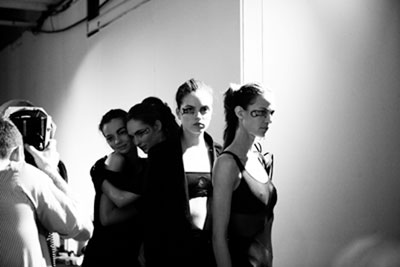
Photography courtesy of Interwoven

Coinciding with the Capital Fringe Festival 2010, INTERWOVEN kicks off tonight at the Textile Museum in Washington, DC. Sponsored by the Danish Embassy and DC’s NPR affiliate, the two-night event will push the boundaries of both textile and performance art through a melding of the two.
INTERWOVEN will feature the first-ever American appearance by designers and artists Henrik Vibskov and Andreas Emenius, whose previous work, The Fringe Project, explored the nature of physical surfaces and movement, all through fringes. The pair claimed their inspiration came after watching the film Solaris and “staring at a New Years Eve party hat”. Additionally, avant-garde fashion label threeASFOUR will perform, as will fashion designer Peggy Noland. Screenings by artists such as Hrafnhildur Arnardottir, a.k.a. SHOPLIFTER — who is perhaps most widely known for being the mind behind the cover image of Björk’s 2004 album, Medulla — will most definitely be highlights.
INTERWOVEN: Evenings in Performance will be at the Textile Museum, 2320 S Street, NW Washington, DC on July 23 & 24, from 8 to 10 p.m.
(more…)






 Facebook
Facebook Permalink
Permalink Digg
Digg Reddit
Reddit LinkedIn
LinkedIn StumbleUpon
StumbleUpon Tumblr
Tumblr